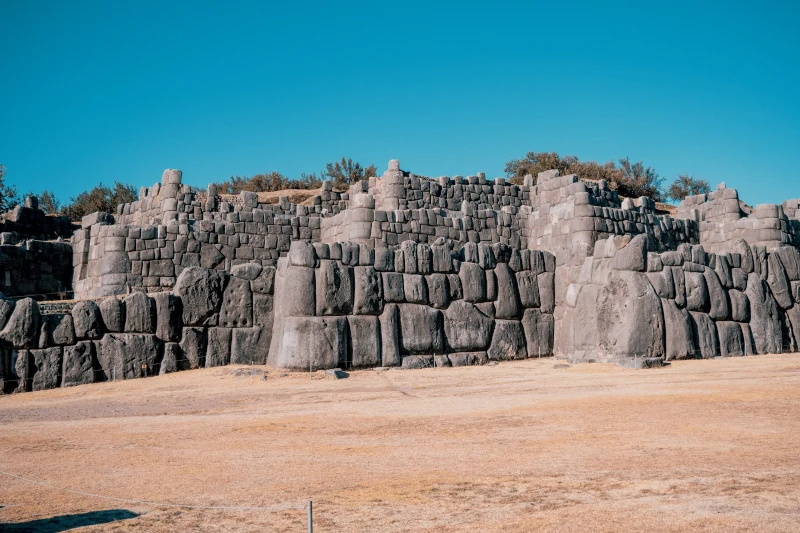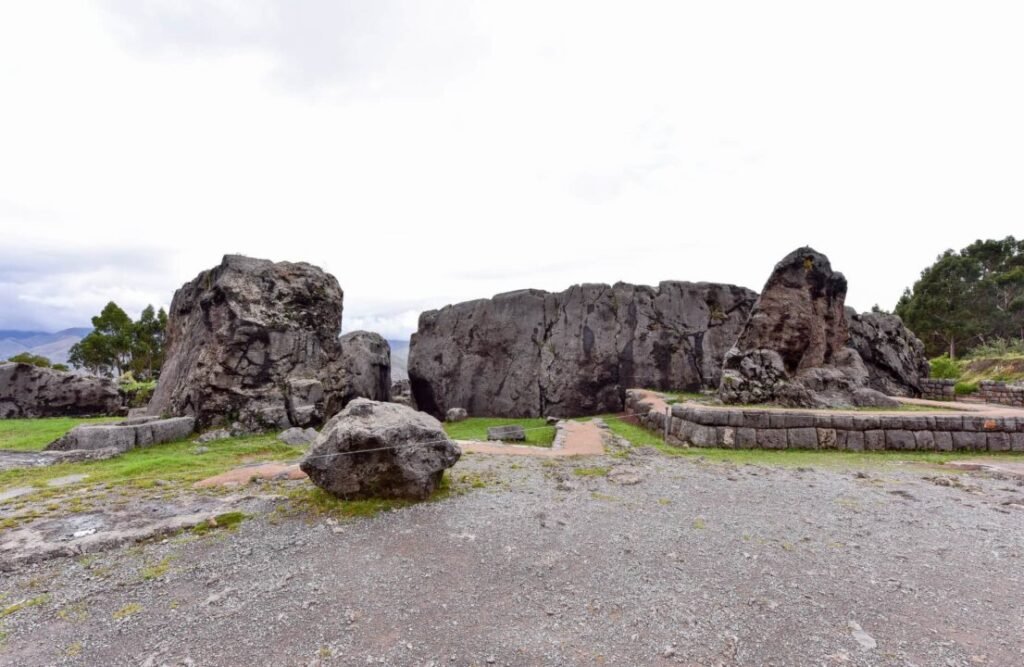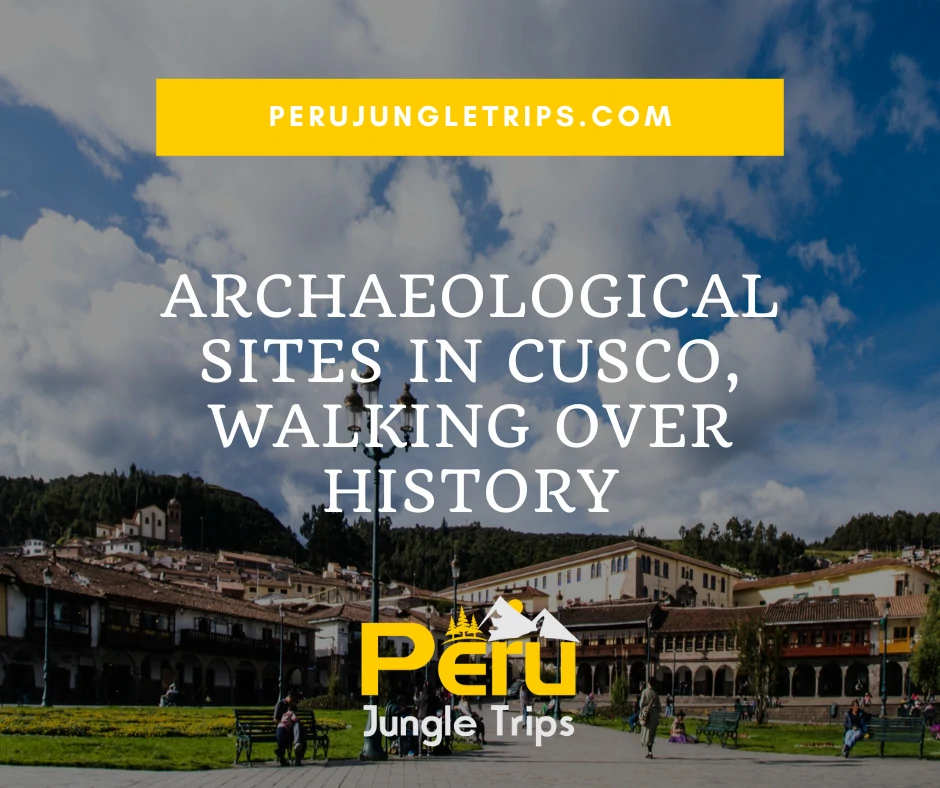The vibrant city of Cusco is a treasure trove of history, with its centuries-old cobblestone streets and impressive architecture providing a window into a fascinating past. But Cusco’s allure extends far beyond its charming streets. It is also home to an array of captivating archaeological sites that transport visitors on a journey through time.
In this article, we will explore some of the most significant and awe-inspiring archaeological sites in and around Cusco, delving into their rich history and cultural significance. As we embark on this adventure, we invite you to walk over history, unraveling the mysteries of a once-great civilization that continues to captivate the world to this day.
SACSAYHUAMAN
Sacsayhuaman (from Quechua saqsay = to be full, and waman = hawk, meaning “sated hawk”) is an Inca “ceremonial fortress” located two kilometers north of the city of Cusco.
Its construction began during the reign of Pachacutec in the 15th century; however, it was Huayna Capac who gave it the final touch in the 16th century. From the fortress, a unique panoramic view of the surroundings including the city of Cusco can be observed from the Cruz Moqo lookout.
Location
The “ceremonial fortress” of Sacsayhuaman is located 2 km from Cusco, the capital of the ancient Inca Empire; it is at an altitude of 3,700 meters above sea level and covers an area of 3,093 hectares. The valley is surrounded by the Ausangate, Pachatusán and Cinca mountains, and is bathed by the Tullumayo River. This area has a landscape of great beauty, abundant flora and fauna, among which llamas and hawks stand out.
History
The construction of Sacsayhuaman, according to information that can be extracted from ethnohistorical sources, is said to have been initiated during the reign of the Inca Pachacutec, then continued during the government of Tupac Yupanqui and concluded with Huayna Capac.
During these three generations, according to Inca Garcilaso de la Vega, there were four illustrious builders who successively directed the work. From oldest to most recent, these figures were: Apu Huallpa Rimachi, Inca Maricanchi, Acahauna Inca and Callacunchuy.
These architects are responsible for the design of Sacsayhuaman, which according to many chroniclers, in addition to the ceremonial and military function it fulfilled, also represented a head, which together with the complex of the city of Cusco formed the figure of a puma.
Architecture
The construction itself is peculiar since some of the stones found there are giant, making one wonder how they managed to transport them.
The stones were fitted together with almost unimaginable precision. It is inexplicable, for Westerners, to decipher how the Incas were able to cut the stones with such mastery that not even a knife blade fits between two stones. The complex also consists of a kind of large stone slides where visitors can slide down. The velvety smoothness of the stone stands out in these formations.
There are figures designed on the stones and rocks, entrances to underground tunnels or chicanes, amphitheaters, ritual constructions, probably related to the cult of water. This site played an important role in Inca ritual activities.

It is thought to have corresponded to a military fortress, where warriors were trained. There are doubts about this, since according to its architecture it could have had a religious purpose and been built as a great temple to the Sun god. However, during the time of the conquest it showed its effectiveness as a fortress to defend the city. Its main characteristic is the way it was built; it has large stone blocks, the highest reaching 9 m.
It is stated that its construction took approximately 50 years, beginning in the period of the Inca Tupac Yupanqui. It was supposedly built by 20,000 men. Within the fortress there were large stores of food and weapons, as well as channels for water distribution. The Inca’s throne, located next to the fortress, consisted of a large carved and polished rock on several levels, from where the sovereign presided over festivals, celebrations, parades and gave orders.
Today there are vestiges of the three staggered walls built of sedimentary limestone of fassilifer formation. Sacsayhuaman is divided into different sectors: Sacsayhuaman, Rodadero, Inca’s Throne, Warmi K’ajchana, Inca’s Bath, Amphitheaters, Chincana, Tower Bases, among others.
Inti Raymi
In Sacsayhuaman, on June 24th, the winter solstice, the annual Inti Raymi festival is held where the Inca ritual of worshiping the sun god or inti is recreated. The local people mobilize wearing colorful costumes and dancing typical dances, thus repeating the tradition of their ancestors. Visitors from all over the world come to this festival and reserve their places well in advance.

Q’ENQO
4 and 6 km (5 min northeast of Cusco) by paved road are the archaeological sites of Q’enqo. There are two places: the Large one, which is located at the foot of the road that goes from Sacsayhuaman to Pisac; and the Small one, which is 350 meters west of the former, on the hillside.
This shrine is located on what is now known as Socorro Hill and covers an area of over 3,500 square meters.
Q’enqo Grande (The Large One)
The Amphitheater
During the Incan period, this place was a temple for public ceremonies. It is an enormous semicircular area 55 meters long with 19 incomplete niches distributed along the wall.
Some publications state that the niches were arranged around the amphitheater as seats for the entities that were worshipped, but according to recent research it is very likely that they were actually the bases of a large wall. In front of the open area there is a large 6-meter high stone block resting on a solid rectangular pedestal. It is possible that it was a gigantic sculpture that must have had zoomorphic modeling.
The lack of precision is due to traces of destruction caused by the extirpators of idolatry (people in charge of eliminating local cult icons) during the Colonial period. It also has a rocky outcrop decorated with a passage leading to an underground chamber, a complex of terraces, rooms and a drainage system to evacuate water from the site.

Intihuatana and Astronomical Observatory
On the flattened and polished living rock two short cylinders protrude. It is likely that it was an intihuatana, which translates to “place where the sun is tied”, that is, it allows calculating the position of the sun. It is not known how this artifact worked. It remains an enigma to this day. But it is presumed to have been a kind of astronomical observatory used to measure time, to establish the seasons, determine the solstices and equinoxes, and as a shrine it was a place of worship to the Sun, the Moon, Venus and the stars.
Cusilluchayoc
This is a Quechua name that means “temple or place that has monkeys”. It is located 500 meters directly east of Qenqo Grande. It has a carved stone almost two meters high that some believe resembles the shape of a toad. On that rock, reliefs of snakes and monkeys that may have given the place its name are still visible.
The Underground Chamber
The rock carving done here is a real feat. Floors, ceilings, walls, tables and niches were carefully carved into the living rock. Undoubtedly, it was a place of worship for secret and hidden rituals. The builders completed its layout with service rooms around the perimeter. It also has terraces and channels for rainwater drainage.
The Carved Stone
Behind that stone rises a rocky promontory where a staircase carved into the living rock leads to the summit. There the small zigzag canal is born which, starting from a smaller hole, descends and then bifurcates into one branch that follows the slope and another that reaches the underground chamber inside the rocky outcrop. It may have served to conduct the chicha (corn beverage) offered or the blood of the llama sacrifices from some ritual not yet clarified. At the same summit there are carved remains of what could have been a condor, whose head was broken, as well as that of a puma. There are also remains of a room.

The Zigzag Canal
It is located very close to the intihuatana. The Cusco historian Víctor Angeles describes it as follows: “starting from a small hole, it moves along an inclined plane and broken line, then bifurcates, one of the branches conducted the liquid set in motion to the Underground Chamber or Room of Sacrifices“. The liquid could have been the blood of the sacrificed beings (animals and/or humans) to the gods.
The Mortuary Chamber
The mystery of Andean worship is one of the attractions of Inca culture. Regarding the so-called “Room of Sacrifices”, doubts still have not been resolved. It is an underground chamber, entirely carved into a gigantic rock. In the lower portion of the great rocky outcrop, the floor, ceiling, walls, tables, cupboards and voids are carved. It is said that this underground chamber may have been used to embalm nobles, but it is also possible that human and animal sacrifices took place there.
Qenqo Chico (The Small One)
The Qenqo Chico site, much more destroyed than Qenqo Grande, shows remains of high walls, circular planning and the same careful carving of the rock.

PUCA PUCARA
Puca Pucara is an archaeological complex on the way to Tambomachay, forming part of the tourist routes in Cusco. Its functions and the reason for its construction are still unknown to archaeologists, however, traditional information indicates that when the Inca was going to visit the baths of Tambomachay, the formidable entourage of soldiers, dancers and others, stayed at Puca Pucara which was a barracks and tambo (collective lodging with food stores).
Architecture The builders erected three walls with an irregular plan that establish three levels for the site. The first wall has a winding layout that carefully avoids cutting the protruding rocks. Towards the north and behind the outer wall, there are six rooms of different sizes, arranged irregularly so as not to touch the stones that make up the wall. To the west, there is a high trapezoidal plaza accessed by a staircase from the outside. The plaza was surrounded by buildings on two of its sides. The nine regularly laid out rooms in this open space do not seem to belong to a fortified area. A second wall surrounds the central elevation. Between this and the first, there are wide terraces towards the south and east. Behind the second wall there are three atypical rooms for Inca architecture, since two of them do not have a rectangular but rather a trapezoidal plan. The third wall surrounds the summit and no traces of the buildings have remained.
Location Puca Pucara is located on the east side of the road and one kilometer before reaching Tambomachay. The site occupies another of the typical rocky outcrops that stand out on the Sacsayhuaman plain. The archaeological group of Pucapucara is located on the paved road leading to Pisac, 7 km from the city of Cusco, at an altitude of 3,680 m.a.s.l.
Etymology
The word comes from the Quechua words puca, “red” and pucara, “fortress or defended place”. Indeed, the stones of the place are reddish and this explains its name, but the site does not seem to have been a fortress.

